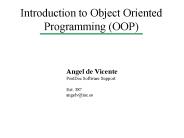Introduction to Object Orientation - PowerPoint PPT Presentation
1 / 25
Title:
Introduction to Object Orientation
Description:
A category of objects that share the same attributes, operations, relationships, semantics ... Attributes. Operations. 7. What Is an Attribute? ... – PowerPoint PPT presentation
Number of Views:29
Avg rating:3.0/5.0
Title: Introduction to Object Orientation
1
Team-Based DevelopmentISYS321
- Introduction to Object Orientation
2
Unified Modeling Language (UML)
- A standard notation for representing
object-oriented systems - Boxes represent classes, components, packages,
objects - Containing attributes and operations
- Provide interfaces to external entities
- Lines represent generalization and other
relationships
3
Sample UML Diagram
4
What Is an Object?
- An entity that encapsulates data and behavior
- Objects are categorized into classes
- Each individual object is an instance of a class
5
What Is a Class?
- A category of objects that share the same
attributes, operations, relationships, semantics - All objects are instances of classes
- Consider a business object such as SalesOrder -
Attributes could include order date while-
Operations could include calculate order
total- These objects would be in the SalesOrder
class
6
Name
Attributes
Operations
7
What Is an Attribute?
- Attribute- a named property of a class that
describes a range of values that instances of the
attribute might hold - Attributes are the way classes encapsulate data
8
Attributes are properties containing values
9
What Is an Operation?
- A behavior of an object
- Classes contain methodssignature
- Methods are identified and invoked by their
signatures (including name, parameters, and
return type)
10
Signature identifies and invokes the behavior
Method implements the behavior
11
What Is Encapsulation?
- The characteristic of object-orientation in which
data and behavior are bundled into a class and
hidden from the outside world - Access to the data and behavior is provided and
controlled through an objects interface
12
Method signatures
13
What Is Generalization?
- A relationship between a more general (or parent)
class and a more specific (or child) class - The more specific class has additional attributes
and operations
14
What Is Inheritance?
- The mechanism by which the more specific class in
a generalization relationship includes the
attributes and operations of the more general
class - The child inherits attributes and operations from
parent
15
Generalization represented by arrows from
subclass to superclass
Subclasses inherit all attributes and operations
of superclasses
16
What Is Polymorphism?
- The ability for different classes of objects to
respond to identical messages in different ways - Polymorphism having many forms
- Different behaviors for the same message
- This is a very important requirement for
component-based development
17
Here, each type of vehicle has its own version of
calcPrice()
18
What Is an Interface?
- The mechanism by which users of a component
invoke its behaviors and manipulate its
properties - The interface is implemented by method signatures
19
What Is a Component?
- A replaceable part of a system providing a
clearly defined function through a set of
interfaces - Group of classes working together toward a common
end a subsystem - Fosters reusability
20
Interfaces are represented as small rectangles
21
What Is a Package?
- A general-purpose mechanism for organizing
elements into groups - Group of classes sharing similar characteristics
or purposes
22
(No Transcript)
23
What Is an Association?
- A relationship or link between instances of one,
two, or more classes - Three types
- Simple associations no ownership
- Aggregations part-whole relationships where the
part can exist independently of the whole but the
whole has no meaning without the parts (ie. Team
has members) - Compositions part-whole relationships where the
part and the whole are fully dependent on each
other(i.e. sales order and its line items)
24
This is a binary association, showing roles and
multiplicities
25
- Any Questions?































